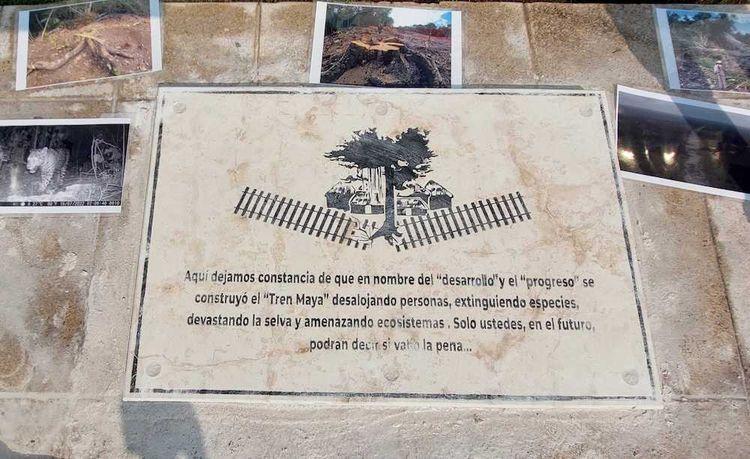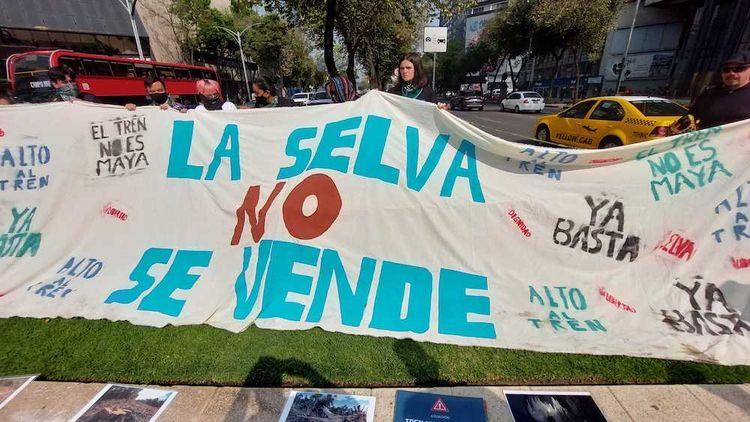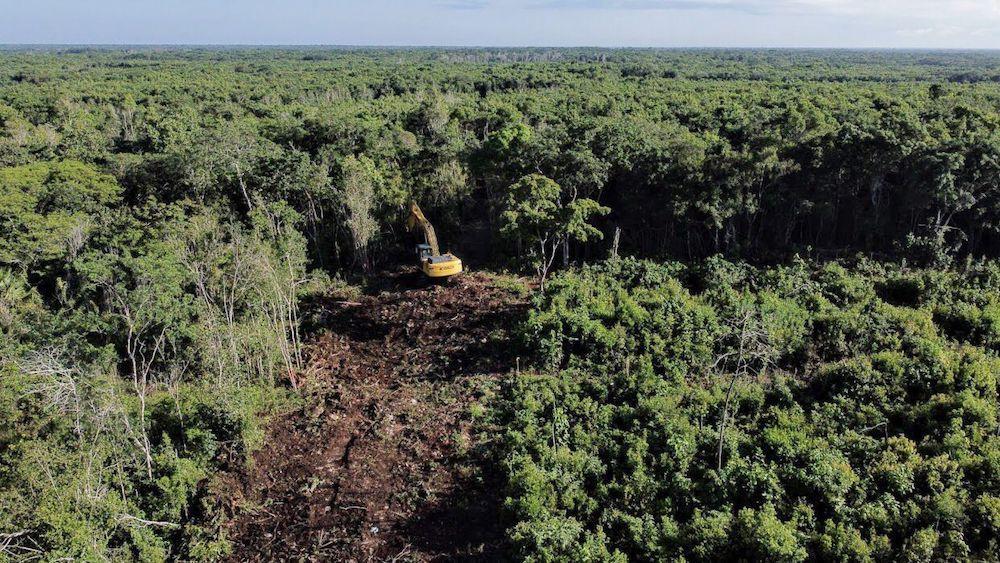“Here we record that in the name of 'development' and 'progress', the Mayan Train was built, evicting people, extinguishing species, devastating the jungle and threatening ecosystems,” reads the legend placed on a plaque on Paseo de la Reforma Avenue, in Mexico City, by environmentalists who oppose the megaproject in the Yucatan Peninsula, promoted by the federal government.
With a view to being completed before the end of the six-year term, the Mayan Train advances by leaps and bounds in the first five sections, from Palenque, Chiapas, to Tulum, Quintana Roo. Sections six and seven are being planned to connect the entire railway circuit of more than 1,500 kilometers in southeastern Mexico.
To move forward in this way, the federal government has had to violate all environmental laws, court rulings and local development plans, said biologist and activist Roberto Rojo, a member of the Selvame del Tren collective, which seeks to make the government aware of the damage caused by train construction to the environment.
In an interview with Journalism CN, Rojo asserted that the project puts at risk the region's jungle, one of the most important forest areas in Latin America, due to habitat fragmentation, irreversible damage and excessive growth.
“We came to denounce an ecocidal tax project that has been based on lies and deception against the population and that has been illegal,” said the environmentalist during the installation of the anti-monument plaque.

Plaque placed on Paseo La Reforma in protest against the Mayan Train. Photo: Alejandro Castro
“It's a capitalist project that will end our territories,” added a member of the Yucatan-based organization Kanan Human Rights. He omitted to mention their name, he said, because of the climate of hostility they live in the region.
According to the latest progress report from the National Fund for Tourism Promotion (Fonatur), the agency in charge of the work, work is being carried out in the first four sections for the installation of roads and secondary works. In Section 5, dismantling and flattening work continues.
According to the director of Fonatur, Javier May, the Train will be inaugurated in December 2023.
The promoting agency already has environmental permits up to Section 6.
Until Section 5, all works were started without authorization from the Ministry of Environment and Natural Resources (Semarnat).
The Maya Train will pass through 40 municipalities and 181 towns in Chiapas, Tabasco, Campeche, Yucatán and Quintana Roo.
Along the route there will be 20 stations and 14 bus stops, which are already under construction.
In addition, six garages and three workshops are planned for protection, repairs and maintenance for the 42 trains, in addition to eight track maintenance bases.
“The Southeast has its best ally on the train to recover local ecosystems,” reads the work's website. The Federal Government assures that the project has the possibility of restoring the biological connectivity of natural areas to care for animals and vegetation; promoting the conservation of ecosystems and environmental services and rehabilitating degraded ecosystems, especially in Protected Natural Areas, as well as reducing illegal logging.
Throughout the construction of Section 5 South, which runs from Playa del Carmen to Tulum, the Secretariat of National Defense (Sedena), responsible for the section, placed signs that allude to the sustainability of the project.
There, in that area, millions of trees have been cut down, Roberto Rojo said.
“They told us that not a single tree was going to be felled and in Section 5 alone 8.7 million trees were thrown down, we estimate, although there may have been many more (the authorities have only acknowledged the felling of 300,000). It has been a very bleak and disheartening process, realizing the deceptions against the people, the lies of the government,” said Rojo.
The Selvame del Tren collective tried to temporarily stop the project by legal means, but the amparos were finally dropped in September by the First District Court based in Mérida, Yucatán, in which all cases related to the Maya Train fall.
Pedro Uc, a member of the Muuch Xiinbal Maya Territory Defenders Assembly and opponent of the project, recognizes that the amparos have not been an efficient way to stop the megaproject, because even after the suspensions have taken place, the works have not stopped.

Members of various groups met in Mexico City to reject the megaproject. Photo: Alejandro Castro
The activist pointed out that communities resorted to amparos as a way of resistance, in the face of questions that organizations such as the Zapatista National Liberation Army (EZLN) have received to pose armed resistance. However, he said that legally they have not been heard.
“The EZLN asked, well, if it's not weapons, what other paths do we have to take? We have resorted to amparos, we have marched, we have held rallies, we have gone on hunger strike, we have done everything that is supposed to be enshrined in the Constitution and they have ignored us, now that we pull the trigger of hope they are telling us that this is not the way. So if that's not the way, what is it then?
Today we are being invisible, I don't know what will happen tomorrow if our young people one day raise their voices and lift up the forces that the communities confer on them, that they don't say later that we are not following the paths traced by the Rule of Law,” he said.
Uc alleged that there is an “authoritarian tendency” on the part of the Federal government that generates an “incendiary” environment.
“Our rights are being violated by an insensitive government like this, a government that is deaf, blind to our needs. It does not help democracy and has no possibility of responding to the specific needs of indigenous peoples. If there is one forgotten sector today, it is precisely that of indigenous populations,” he added.
For environmentalist Aracely Domínguez, from the environmental collective Grupo Ecologista del Mayab, the federal government has used unethical strategies, such as the presidential decree that gave infrastructure projects a “national security” character, in order to circumvent environmental regulations.
“They turned the law around to find a format that we know is unconstitutional. They are still fighting not to comply with the Law, because they want to end forcibly and comply with a political program, without thinking that nature has no political times,” he said.
There is no dialogue between indigenous communities and environmentalists who disagree with the federal government, the representatives of the groups acknowledged. Nor do they see any possibility of it existing in the future.
For Roberto Rojo, what is next for those who are unhappy with the project is to “not give up” and to make known nationally and internationally what, in his position, will be devastating for the region.
“We came to install the antimonument, as a reminder of this reality, and
that, in the future, no one asks us “And where were they when the Mayan train wiped out the jungle and the jewel of the Southeast”, concluded the member of the Mayab Speleological Circle.



Comentarios (0)